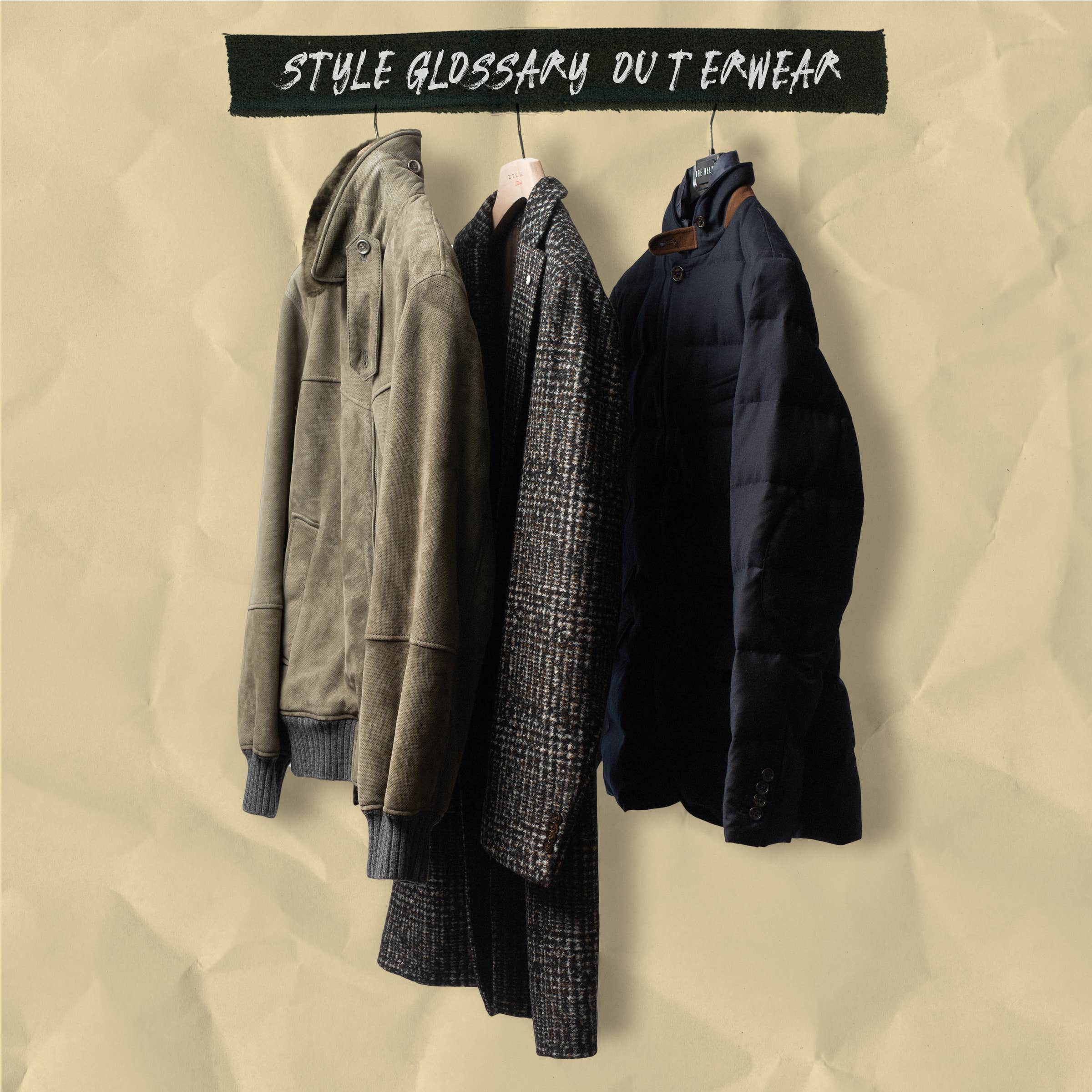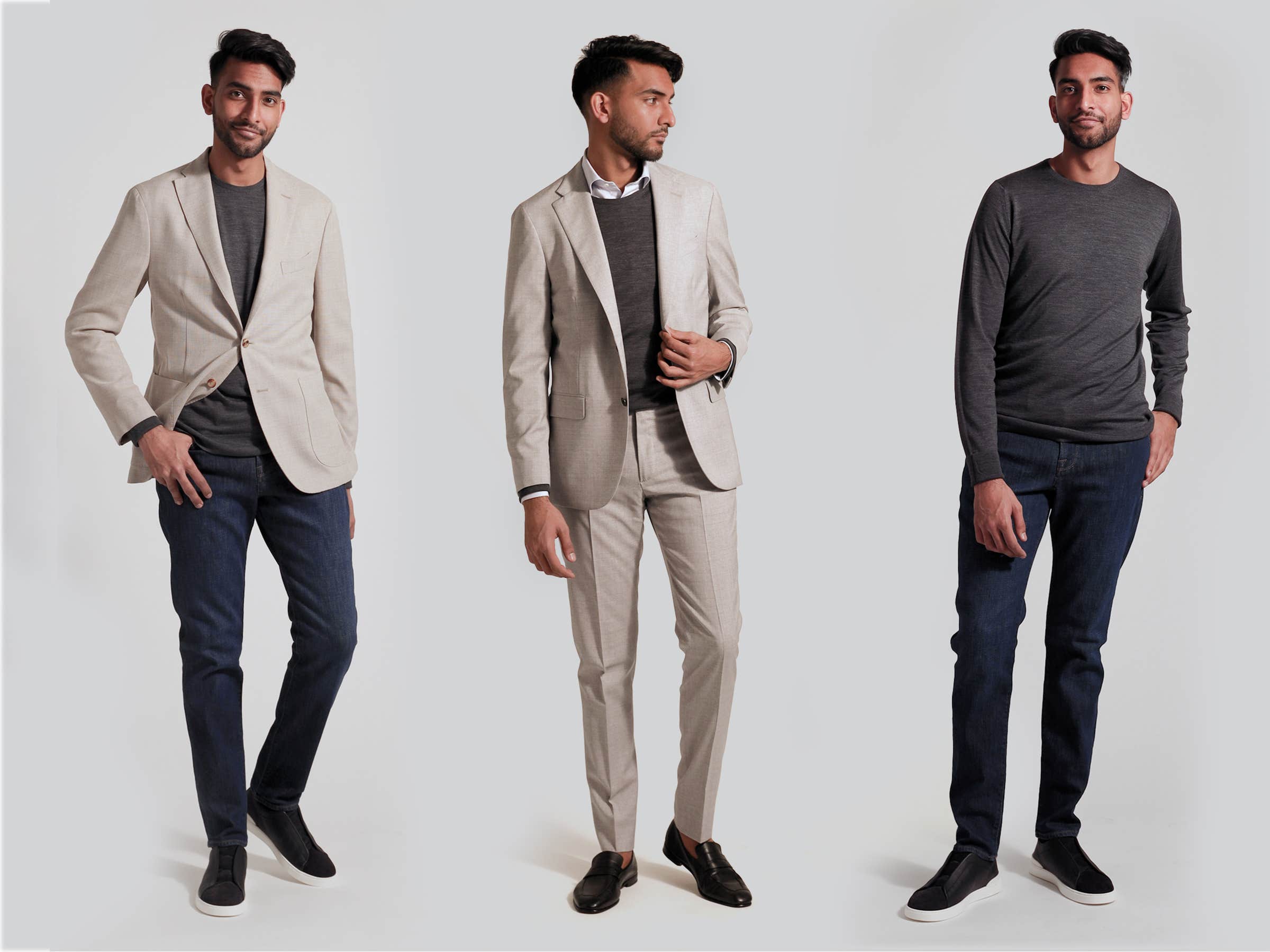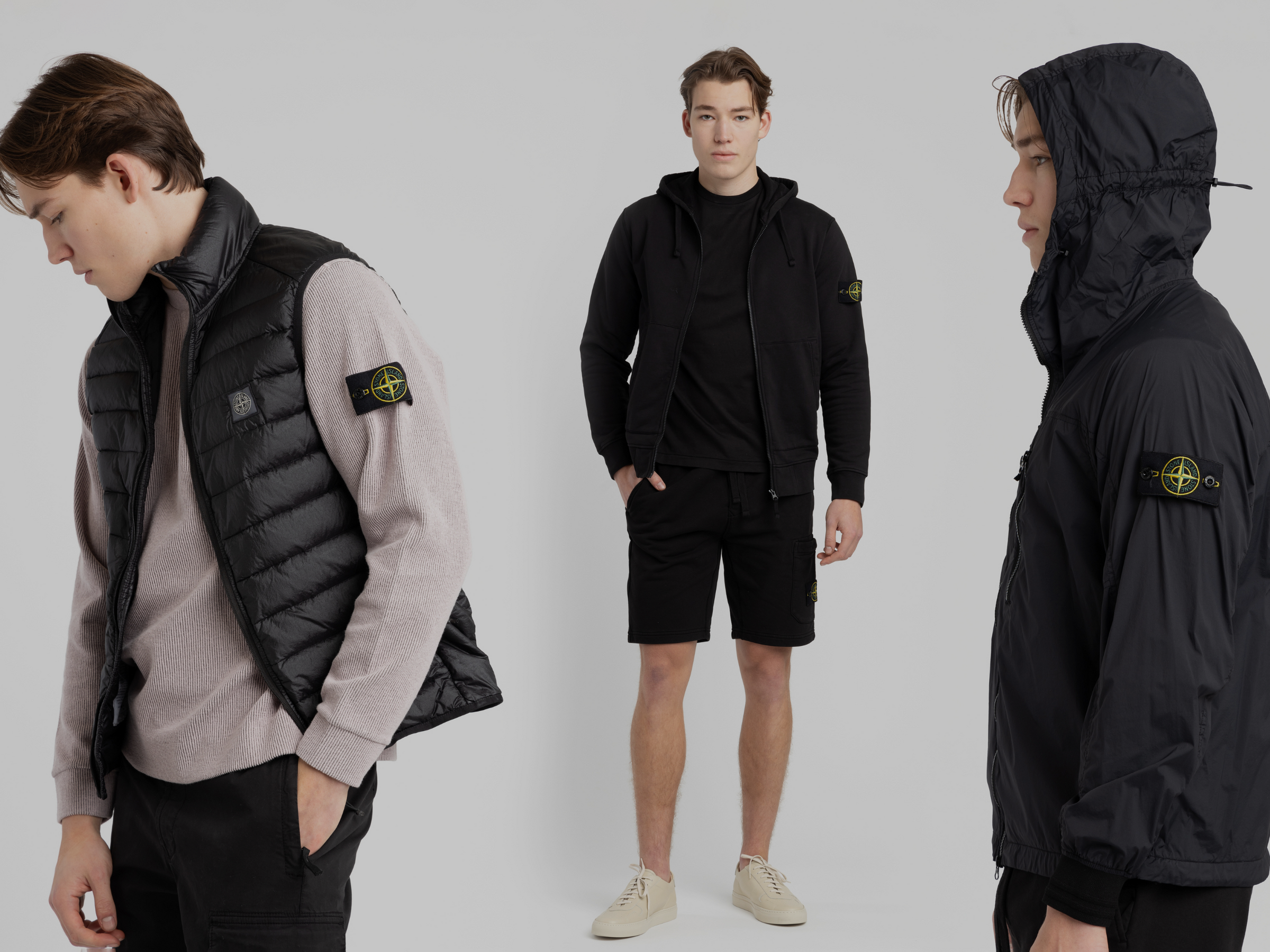
We love digging into the nitty gritty of men’s clothing. Last time we focused on suits, and this time we're digging into outerwear.
What’s the difference between a mac coat and a trench coat? When should you wear an overcoat versus a peacoat? We’ve got the answers!
Most men will want a few different coats in their wardrobe, depending on your lifestyle. Here are 34 terms that you might come across when shopping for outerwear so you know exactly what you’re looking at.
Types of outerwear - Long coats
Car coat - Initially designed to keep drivers warm in uninsulated cars in the early days of automobiles, it has an upper-thigh length so the extra fabric doesn’t bunch up under the wearer’s legs while sitting. It has a subtle a-line cut and a straight collar rather than a large lapel, so you can button it right to the top. It is often made using wool, but spring/summer versions can be found in cotton as well.
Duffle coat - A British mid-thigh or knee-length coat, typically made of thick wool with wood or horn toggle fastenings. They have two large patch pockets on the front and an oversized hood. This is a smart-casual coat, not a dressy one.
Great coat - Similar to a wool overcoat, but typically heavier and longer with a looser fit. They are also characterized by a double-breasted closure and often have other military-inspired features, such as metal buttons or epaulettes.
Mac coat - A raincoat first designed in the 1800s, similar in length to a trench coat but with much more simple styling typically. It has a stand collar rather than a large lapel, and it isn’t belted like a trench coat is. Today’s versions are usually done in a water-resistant cotton fabric.
Parka - A heavy winter jacket that typically features a fur-lined hood and an upper- to mid-thigh length. Parkas were originally invented by the Caribou Inuit and were later adapted by Antarctic explorers. Today’s versions often have a waterproof outer layer, a hidden drawstring at the waist, and down or synthetic insulation.
Polo coat - A camel-coloured, mid-thigh length coat that is characterized by a half-belt, patch pockets, and an oversized peak lapel.
Top coat - A top coat is very similar in style to an overcoat, but it is lighter weight for warmer weather, and it tends to be shorter in length, hitting around mid- to upper-thigh.
Trench coat - Inspired by military outerwear, trench coats are characterized by their large lapels, double-breasted closure, and belted waist. They’re typically made of a cotton gabardine, which makes them ideal for the transition seasons.
Overcoat - A winter menswear staple that became popular in the 18th century. Overcoats are made of wool or a wool blend fabric and are meant to be worn over suits, but they can be worn with smart-casual attire as well. It typically has a button closure and slant pockets and the length hits around the knee.
Types of outerwear - Short coats

Anorak - A weather-resistant, hip-length, pull-over style jacket, usually with a hood and a partial-zip closure.
Biker jacket / moto jacket - A leather jacket that features an asymmetrical zip closure, snaps on the lapel, and a belted waist.
Bomber jacket / flight jacket - A short jacket with ribbed cuffs and a cropped waist, styled after jackets worn by flight crews in the military. Often done in either nylon or wool fabric and insulated with a down or synthetic fill.
Chore jacket / barn jacket - A casual jacket with a boxy fit, usually made of thick cotton or wool material with large, functional patch pockets on the front.
Down jacket - A winter outerwear piece that is insulated with a down fill. Typically these are done in a quilted style (or puffer style) to create baffles, or stitched compartments, that keep the insulation evenly distributed.
Field jacket - A military-inspired jacket originally created for American soldiers during WWI. It has four large patch pockets on the front and tends to be lightweight and slightly oversized for layering purposes.
Harrington jacket / blouson - Originally designed in the 1930s, a Harrington is a short, lightweight, and roomy jacket that was originally used for golfing. It has a stand collar and is casual in style.
Peacoat - Designed for Naval officers in the 1800s, peacoats are typically made of sturdy wool twill cloth with a double-breasted closure and a shorter length than an overcoat to allow for better range of motion. They have an oversized lapel that can be worn upright to protect from the wind. These are easily dressed up or down.
Puffer jacket / quilted jacket - Puffer or quilted jackets have stitching throughout the body that creates a pillowy effect. They can be made using down or synthetic insulation. Depending on the type and weight of the insulation, these jackets can be quite warm and lightweight. Smaller, diamond-shaped quilting gives a more rugged appearance, whereas horizontal or vertical quilting tends to create a more classic look.
Safari jacket - Similar to a field jacket with four front bellowed patch pockets on the front, but with a belted waist and epaulettes. They are typically made from lightweight khaki cotton that is protective but not too warm.
Shacket / shirt jacket / overshirt - A transitional outerwear piece that is essentially a heavier, looser version of a casual button-up shirt. It can also be worn under other outerwear, similar to a cardigan.
Shearling jacket - A traditional shearling jacket is made from lamb or sheep skin with the wool still attached to create the lining. A shearling jacket can come in many different styles, but you’ll often see it in a bomber cut. Shearling (or faux shearling) linings and collars are also often used on trucker jackets and other casual outerwear.
Technical jacket - This term is often used to describe any outerwear that combines a number of functional aspects, like vents, waterproof fabric, mesh, etc. to make it as useful as possible for a particular purpose, such as skiing or hiking.
Trucker jacket - The typical “denim jacket” style of outerwear, with a cropped cut that ends at the hips and has buttoned chest pockets with pointed flaps. Trucker jackets are also often seen in corduroy, canvas, and suede.
Varsity jacket / letterman jacket - Similar to a bomber jacket with a short length and banded cuffs and waist, but with often with contrasting leather sleeves, while the body is done in wool.
Outerwear details

Double-breasted - A jacket with two columns of buttons. The fabric overlaps when closed. It typically will have four or six buttons. This style of closure is often seen in peacoats, polo coats, and some styles of overcoats.
Feather ratio - The 80/20 or 90/10 number you may see used to describe down jackets indicates the ratio of down to feathers used in the insulation. The higher the ratio, the better quality the insulation is.
Fill power - A measure that indicates the number of cubic inches one ounce of down occupies, determining how lofty the down is. A higher fill power, or a loftier down, means there is more air between the fibres, which can create a warmer effect with less weight. Note that fill power alone does not indicate the level warmth. Anything over 700 fill power is considered very good quality, and 900 fill power is about as high as it gets.
Gore-Tex - A brand-name, waterproof fabric membrane that allows fabrics to maintain their breathable qualities.
Hand warmer pockets - Slanted pockets on outerwear, typically around chest-height that are intended to keep the wearer’s hands warm. They’re often lined in an insulating fabric.
Sherpa - a warm, plush synthetic fabric made to look like wool fleece.
Stand collar - A collar with a stiff band that stands straight up, covering the neck.
Ventile cotton - A brand of uncoated, long-staple cotton fabric that is woven using a tightly compressed weave and is finished with a durable water repellency finish that makes it nearly waterproof.
Waxed cotton - A breathable cotton fabric with a wax coating to keep moisture and wind from penetrating the coat, traditionally used for hunting outerwear. Waxed cotton typically needs to be waxed once per year to maintain its properties.
Windfly - A removable inner layer with a high neck and a zip closure found on jackets with lapels to keep wind off of the wearer’s chest and neck.
--
Like our suit glossary, this is not an exhaustive list of terms. If there’s a term you’d like us to define, send us a note and we can add it!
In the market for a new jacket? Take a look at our outerwear selection online.



